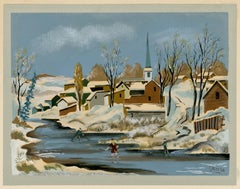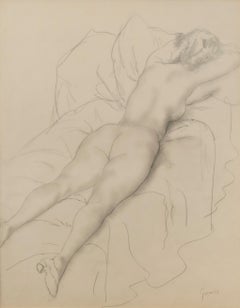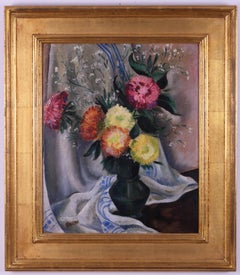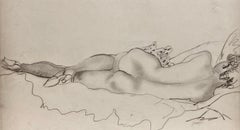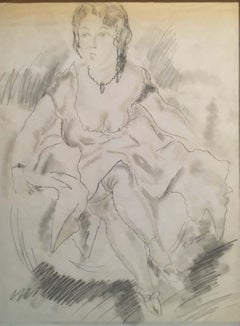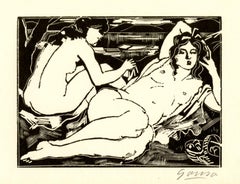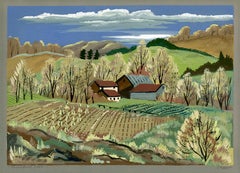Emil Ganso Art
Emil Ganso was born in Halberstadt, Germany, in 1895 and came to the United States as a teenager. By 1914, Ganso was taking evening classes at the National Academy's School of Fine Arts while supporting himself as a baker. His work was soon identified by Erhard Weyhe who went on to show Ganso's work at the Weyhe Gallery. Ganso first exhibited at the Society of Independent Artists in 1921, as well as at the Salons of America from 1922–25. By 1925, Weyhe Gallery began to represent Ganso, which gave him the funds to spend his first summer in the art colony of Woodstock, New York in 1926. Weyhe Gallery continued to exhibit Ganso's work through the 1940s. In Woodstock, Ganso met George Ault, Doris Lee, Charles Rosen, Katherine Schmidt, Eugene Speicher, Alexander Brook, Louis Bouché, Konrad Cramer, Leon Kroll and George Bellows leading Ganso to settle in Woodstock and continue to benefit from Woodstock connections throughout his life. In 1927, the same year he settled in Woodstock, Ganso began to share a studio with Jules Pascin. Ganso printed Pascin's lithographs and prepared a paper for him in 1927–28 while Pascin was in America. In 1929, Ganso visited Pascin in Paris. Perhaps it was this Paris trip that sparked Ganso's interest in photography. By 1930, he was exploring photography as an art form, as well as an aid to his art compositions. Konrad Cramer, Yasuo Kuniyoshi, and Russell Lee were other Woodstock artists who joined Ganso in these photography pursuits. Ganso received a Guggenheim Fellowship in 1933, which he used to study and paint in Europe. In the 1930s, Ganso also kept a studio at 54 West 74th Street, an artists' building, where Walter Pach and Theresa Bernstein also had studios. Leonard Bocour who founded Bocour Artists Colors, which in the late 1940s developed Magna paints and the first acrylics credits Ganso, inspiring him to create artist paints and introduced him to the major artists of the 1930s, including Yasuo Kuniyoshi and Reginald Marsh. Ganso was the first artist Bocour visited while still in high school in 1930 and Ganso taught Bocour how to mix paints and grind his pigments. According to an oral history Bocour gave to the Archives of American Art, Ganso was the master theoretician and leading technical person in Woodstock who all the major artists came to for help with their color due to Ganso's library of German art books including Alexander Dorner's The Way Beyond "Art": The Work of Herbert Bayer which was not translated into English until 1947. In 1930, Ganso began to be invited to exhibit at the Corcoran Gallery of Art, Washington, DC (1930–35); the Art Institute of Chicago; the Wichita Art Museum, Kansas; the Pennsylvania Academy of the Fine Arts (1931–38); and the Whitney Museum of American Art (1927–41). Ganso also exhibited at both the 1939 New York World's Fair and the Golden Gate Exposition in San Francisco that same year. Ganso was awarded the “Pennell Memorial Medal” from the Pennsylvania Academy of the Fine Arts in 1938. As a result of the success of his art, Ganso was offered an artist-in-residence position in 1940 at the University of Iowa. It was there that he died in 1941. A retrospective exhibition for Emil Ganso was held at the University of Iowa Museum of Art both upon his death and in December 1979.
1930s American Impressionist Emil Ganso Art
Gouache, Stencil
1930s American Modern Emil Ganso Art
Graphite
1930s American Modern Emil Ganso Art
Oil
1930s American Modern Emil Ganso Art
Pencil
1930s American Modern Emil Ganso Art
Engraving
1930s Art Deco Emil Ganso Art
Charcoal
2010s Modern Emil Ganso Art
Crayon, Charcoal, Graphite
2010s Modern Emil Ganso Art
Charcoal, Archival Paper, Graphite
2010s Modern Emil Ganso Art
Graphite, Conté
1970s Pop Art Emil Ganso Art
Paper, Charcoal, Wax Crayon
Early 2000s American Impressionist Emil Ganso Art
Giclée, Oil, Canvas
Late 19th Century Academic Emil Ganso Art
Gesso, Paper, Charcoal, Carbon Pencil
1880s Impressionist Emil Ganso Art
Watercolor, Gouache, Lithograph
1920s American Modern Emil Ganso Art
Etching, Drypoint
2010s Modern Emil Ganso Art
Graphite, Charcoal, Paper
2010s Modern Emil Ganso Art
Charcoal, Archival Paper, Graphite
1880s Impressionist Emil Ganso Art
Lithograph, Watercolor, Gouache
Early 2000s Modern Emil Ganso Art
Archival Paper, Charcoal, Graphite
1920s American Realist Emil Ganso Art
Woodcut
1930s American Impressionist Emil Ganso Art
Gouache, Stencil
1960s American Modern Emil Ganso Art
Woodcut
20th Century Emil Ganso Art
Watercolor, Paper
1920s American Impressionist Emil Ganso Art
Drypoint
1930s Modern Emil Ganso Art
Graphite
